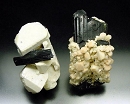
|
| Arfvedsonite |
Chemical
Formula |
[Na][Na2][(Fe2+)4Fe3+][(OH)2|Si8O22] |
Species |
Silicates |
Crystal
System |
Monoclinic |
Mohs
Scale |
5-6 |
Specific
Gravity |
3.3–3.5 |
Color |
Black, deep green on thin edges |
Streak |
Deep bluish gray, gray-green |
Luster |
Vitreous |
Refractive
Index |
n = 1.652 - 1.699 n = 1.660 - 1.705 n = 1.666 - 1.708 |
Diaphaneity |
Translucent, Opaque |
Cleavage |
PerfectPerfect on |
Fracture |
Irregular/Uneven |
| Crystal Habit:Fibrous, radial prismatic aggregates |
| Geological Setting:Alkalic granites and other alkalic rocks |
Arfvedsonite is a sodium amphibole mineral with composition:
[Na][Na2][(Fe2+)4Fe3+][(OH)2|Si8O22]. It crystallizes in the monoclinic
prismatic crystal system and typically occurs as greenish black to bluish grey
fibrous to radiating or stellate prisms.
It is a rather rare mineral occurring in nepheline syenite intrusions and
agpaitic (peralkaline) pegmatites and granites as the Golden Horn batholith in
Okanogan County, Washington (type locality for zektzerite). Occurrences include
Mont Saint-Hilaire, Quebec, Canada; the Ilímaussaq complex in Southern
Greenland; and in pegmatites of the Kola Peninsula, Russia. Its mineral
association includes nepheline, albite, aegirine, riebeckite, katophorite and
quartz.
Arfvedsonite was discovered in 1823 and named for the Swedish chemist Johan
August Arfwedson (1792–1841).


 YueGongAnBei 44051102000467
YueGongAnBei 44051102000467


 |
|